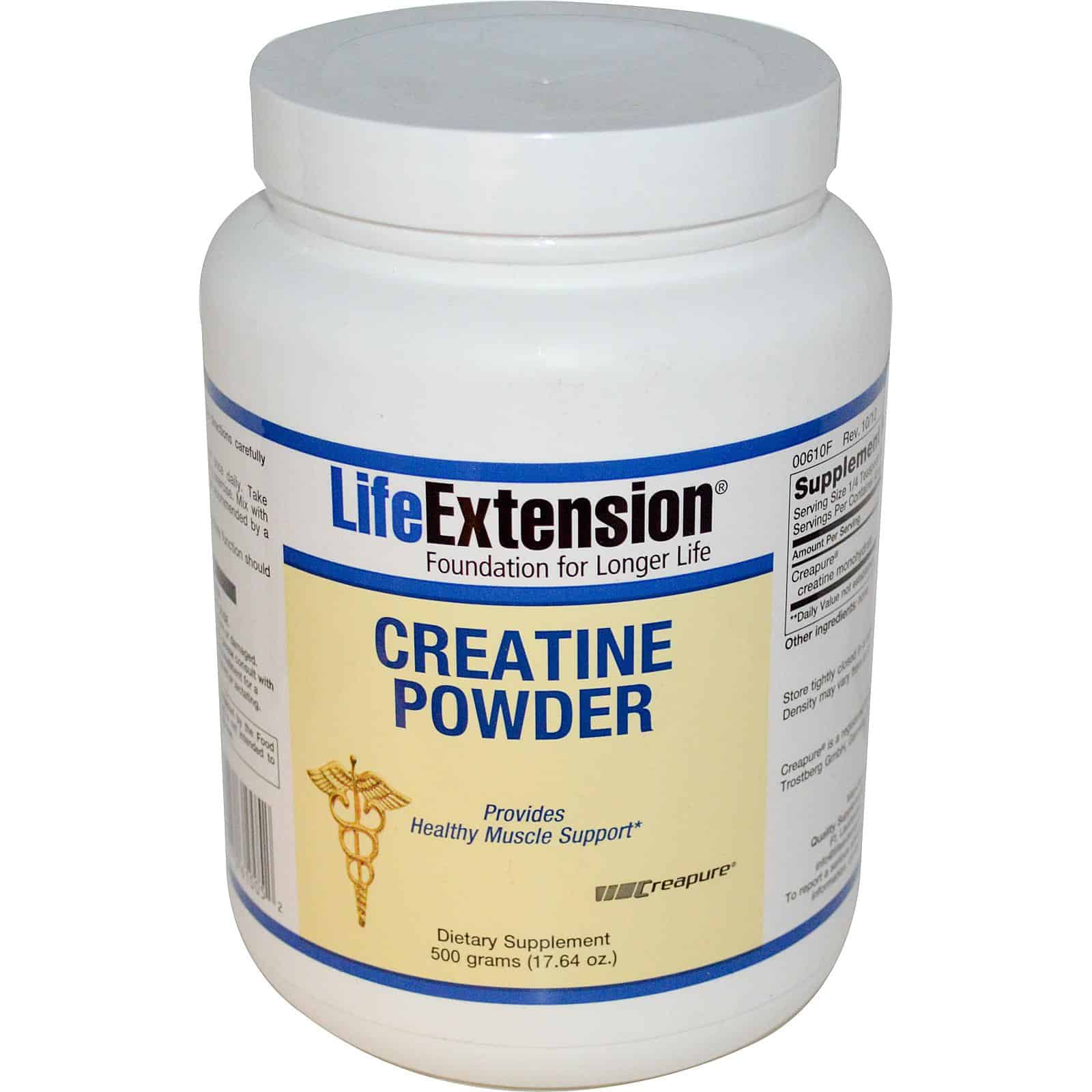Readers of the March 2003 issue of Life Extension magazine should recall the long list of potential medical, performance and anti-aging effects of creatine. The article outlined the substantial body of research that found creatine may help with diseases effecting the neuro muscular system, such as muscular dystrophy and may have therapeutic applications in aging populations, wasting syndromes, muscle atrophy, fatigue, myopathies, Parkinson’s disease, Huntington’s disease and other mitochondrial cytopathies. Several studies have shown it may reduce cholesterol by up to 15% and has been used to correct certain inborn errors of metabolism, such as people born without the enzyme(s) responsible for making creatine.
The article also covered exactly what creatine is, how it works and how much is required to possibly treat the aforementioned pathologies. If you missed that article, refer to the March 2003 issue of Life Extension magazine, or view it at www.lef.org. In this article, we examine some additional properties of creatine, such as its effects on growth hormone release, homocysteine and chronic fatigue syndrome, as well as other important issues surrounding this supplement, such as its safety.
Although data is limited, some research suggests creatine can raise growth hormone equal to that of intense exercise. Growth hormone (GH) is known to play an essential role in the regulation of body fat levels, immunity, muscle mass, wound healing, bone mass and literally thousands of other functions both known and yet unknown. It is well established that GH levels steadily decline as we age and is partially responsible for the steady loss of muscle mass, loss of skin elasticity, immune dysfunction and many other physical changes that take place in the aging human body. Therefore, the possible effects of creatine on GH is worth exploring in aging populations.
One study found creatine could mimic the increased GH levels seen after intense exercise.1 In this comparative cross-sectional study, researchers gave six healthy male subjects 20 grams of creatine in a single dose at resting (non-exercising) conditions. The study found that all subjects showed a “significant” increase of GH in the blood during the six-hour period after creatine ingestion. However, the study also found “a large interindividual variability in the GH response.” That is, there were wide differences among individuals in the levels of GH achieved from taking the creatine. For the majority of subjects the maximum GH concentration occurred between two and six hours after ingesting the creatine.
The researchers concluded “In resting conditions and at high dosages creatine enhances GH secretion, mimicking the response of strong exercise which also stimulates GH secretion.” These researchers felt that the effects of creatine on GH could be viewed as one of creatine’s anabolic properties with the lean mass and strength increases observed after creatine supplementation. Although creatine supplementation has been found to increase lean muscle mass and strength in many studies, the effects of creatine on those tissues via GH enhancement has yet to be elucidated.
Creatine may reduce homocysteine levels
Homocysteine has been recognized as an important independent risk factor of heart disease, more so than cholesterol levels according to some studies. Creatine biosynthesis has been postulated as a major effector of homocysteine concentrations,2 and oral creatine supplements may reduce levels of homocysteine. Many studies have found that methyl donors (such as trimethylglycine (TMG) reduce levels of homocysteine, which also reduces the risk of heart disease. Conversely, pathways that demand large amounts of methyl groups may hinder the body’s ability to reduce homocysteine levels. The methylation of guanidinoacetate to form creatine consumes more methyl groups than all other methylation reactions combined in the human body.
Researchers have postulated that increasing or decreasing methyl demands on the body may increase or decrease homocysteine levels. In one study researchers fed rats either guanidinoacetate- or creatine-supplemented diets for two weeks.3 According to the researchers “plasma homocysteine was significantly increased (~50%) in rats maintained on guanidinoacetate-supplemented diets, whereas rats maintained on creatine-supplemented diets exhibited a significantly lower (~25%) plasma homocysteine level.” These results suggest that homocysteine metabolism is sensitive to methylation demand imposed by physiological substrates such as creatine.
Creatine and chronic fatigue/fibromyalgia
Because of creatine’s apparent abilities to improve the symptoms of other pathologies involving a lack of high energy compounds (e.g., congestive heart failure, etc.) as well as the aforementioned afflictions outlined in the introduction to this article, it has been suggested that creatine may help with chronic fatigue syndrome and fibromyalgia (some researchers now posit that they are in fact the same syndrome). Although the causes of both pathologies is still being debated, a lack of high energy compounds (e.g. ATP) at the level of the mitochondria and general muscle weakness exists. For example, people with fibromyalgia have lower levels of creatine phosphate and ATP levels compared to controls.4 No direct studies exist at this time showing creatine supplementation improves the symptomology of either chronic fatigue or fibromyalgia.
Considering, however, the other data that finds that creatine supplementation increases creatine and ATP levels consistently in other pathologies where low levels of creatine and ATP are found, it stands to reason that people suffering from either syndrome may want to peruse the use of creatine. Another similar syndrome to chronic fatigue and fibromyalgia, is Multiple Chemical Sensitivity Syndrome, which may also be potentially improved by the use of creatine supplements, though more research is clearly needed.
Creatine safety issues: fact or fiction?
After the first article in Life Extension magazine on the many potential medical and anti-aging uses of creatine, I received several letters and many e-mails that basically said “I would like to use creatine for the various reasons stated in the article, but I am worried about its safety.” This fear over the safety of creatine was usually generated from some hysterical news report or poorly researched article. It’s odd, but predictable that the media and conservative medical establishment have desperately tried to paint creatine as an inherently dangerous or “poorly researched” dietary supplement. The fact is, creatine may be the most extensively researched performance-enhancing supplement of all time, with a somewhat astounding safety record.
True to form, the “don’t confuse us with the facts” media and anti-supplement conservative medical groups have had no problems ignoring the extensive safety data on creatine, or simply inventing safety worries where none exists. A perfect example of this was the news report that mentioned the deaths of three high school wrestlers who died after putting on rubber suits and riding a stationary bike in a sauna to lose weight. Amazingly, their deaths were linked to creatine by the media, rather than extreme dehydration! Even more amazingly, on further examination, it was found that two of the three wrestlers were not using creatine!
Creatine has been blamed for all sorts of effects, from muscle cramps to dehydration, to increased injuries in athletes. However, these effects have been looked at extensively by researchers without a single study reporting side effects among several groups taking creatine for various medical reasons over five years.5-8
In some, but not all people, creatine can raise a metabolic byproduct of creatine metabolism known as creatinine. Some people-including some medical professionals who should know better-have mistakenly stated that elevated levels of creatinine could damage the kidneys. Elevated creatinine is often a blood indicator, not a cause, of kidney dysfunction.
That’s a very important distinction, and several short- and long-term studies have found creatine supplements have no ill effects on the kidney function of healthy people.9,10 Though it makes sense that people with pre-existing kidney dysfunction should avoid creatine supplements, it is reassuring to know that creatine supplements were found to have no ill effects on the kidney function of animals with pre-existing kidney failure, showing just how non toxic creatine appears to be for the kidneys.11 Bottom line, creatine safety has been extensively researched and is far safer than most over-the-counter (OTC) products, including aspirin.
Conclusion
Though additional research is warranted regarding the pathologies outlined in this article, creatine has a substantial body of research showing it is an effective, safe and worthwhile supplement in a wide range of pathologies and may be the next big find in anti-aging nutrients. Although the dose used in the studies was quite high, recent studies suggest lower doses are just as effective for increasing the overall creatine phosphate pool in the body. The dose of 2 to 3 grams per day appears adequate for healthy people to increase their tissue levels of creatine phosphate.
People with the pathologies mentioned in this article may benefit from higher intakes in the 5 to 10 gram per day range. People interested in more information regarding creatine, in particular the use of creatine and other supplements for athletes, should consider referring to my ebooks
Will Brink is the owner of the Brinkzone Blog. Will has over 30 years experience as a respected author, columnist and consultant, to the supplement, fitness, bodybuilding, and weight loss industry and has been extensively published. Will graduated from Harvard University with a concentration in the natural sciences, and is a consultant to major supplement, dairy, and pharmaceutical companies.
His often ground breaking articles can be found in publications such as Lets Live, Muscle Media 2000, MuscleMag International, The Life Extension Magazine, Muscle n Fitness, Inside Karate, Exercise For Men Only, Body International, Power, Oxygen, Penthouse, Women’s World and The Townsend Letter For Doctors.
He’s also been published in peer reviewed journals.
Will is the author of the popular e-books, both accompanied by private members forum access , Bodybuilding Revealed & Fat Loss Revealed.
You can also buy Will’s other books on Amazon, Apple iBook, and Barnes and Noble.









I just saved this at Stumbleupon.